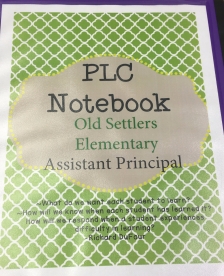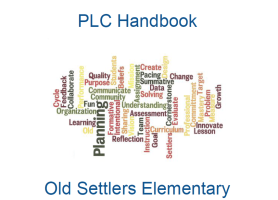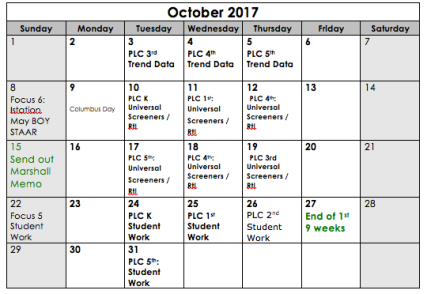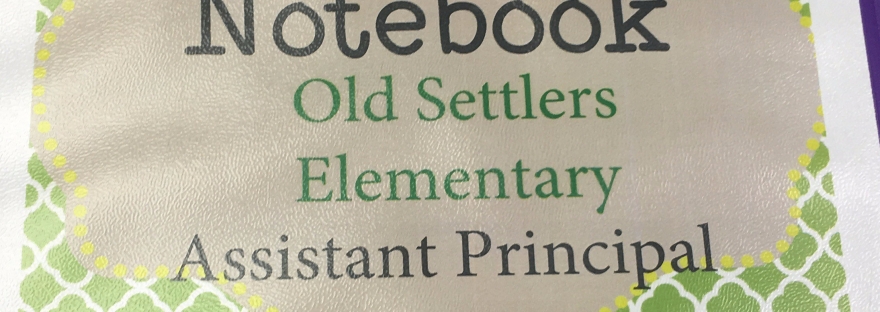Putting Professional Learning Communities Into Practice on an Elementary Campus
*Note: This post includes downloadable templates and videos of some artifacts I created, feel free to use anything you see!
 This year, we are focusing on PLC work. Focusing, as in, starting them up. Yes, we have had PLC time on the calendar. Yes, our teachers have “met” during that time. But would I say we had strong Professional Learning Communities engaged in purposeful PLC-ish type work? Work that drove our instruction and informed our practice as a learning organization? No. And I don’t feel ashamed telling you that. For one thing, I know every educator on my campus would agree. But most importantly, because I believe that if you want to grow and improve in anything, you have to call it like it is. So this year, we took on the task of designing and establishing a vision and framework for supporting PLC work on our campus. To say this was a big, heavy goal would be an understatement. In this post, I am going to reflect on what we have done so far, and where we hope to go on this first leg of our PLC journey.
This year, we are focusing on PLC work. Focusing, as in, starting them up. Yes, we have had PLC time on the calendar. Yes, our teachers have “met” during that time. But would I say we had strong Professional Learning Communities engaged in purposeful PLC-ish type work? Work that drove our instruction and informed our practice as a learning organization? No. And I don’t feel ashamed telling you that. For one thing, I know every educator on my campus would agree. But most importantly, because I believe that if you want to grow and improve in anything, you have to call it like it is. So this year, we took on the task of designing and establishing a vision and framework for supporting PLC work on our campus. To say this was a big, heavy goal would be an understatement. In this post, I am going to reflect on what we have done so far, and where we hope to go on this first leg of our PLC journey.
Developing our Vision
The first thing that my principal and I did was decide on what impactful PLC work would look like for us. We consulted many resources. Our district PLC framework was the guiding focus. It establishes the 3 district PLC principles and some ideas that might fall within each. We consulted books, web resources, journals, people and blog posts which helped tighten up our ideas and inform our processes. Our amazing Director of Professional Learning, Shawna Miller, provided our staff with an introductory PLC training to get us up and going. Finally, we dropped into the #atplc (All Things PLC) weekly Twitter chat where we were able to deepen our understanding of PLC work from some amazing educators. Chats focus on what works, what doesn’t, and latest ideas / trends / practices that are building capacity in educators and administrators. FYI: This chat happens every Thursday at 8:00 pm central time, and is facilitated by Solution Tree. Here is an archive of these chats.
Our guiding focus is on our students and our teachers. What is the work we need to focus on in order to drive high-level achievement at our campus? How could PLCs transform us from a community of learners into a campus-wide learning organization, made up of student and adult learners, focused on a shared vision and common goals? Those were the type questions that drove our dialogue and from which our PLC development began to take shape.
 PLC Campus Handbook
PLC Campus Handbook
Following those ideas and conversations, I sat down to create our campus PLC Handbook. The purpose was to give our staff (and us) a structure for beginning this process. My principal and I are both big proponents of teacher autonomy and we try to be mindful of creating space for teachers to be self-directed. But sometimes, our teachers want a structured system in which to operate as they begin, explore, and get a feel for something new.
Our PLC Handbook is purposefully brief because we are just beginning and the last thing we want to do is make it bigger and more complicated than it has to be. The handbook briefly outlines our purpose and vision for campus PLC teams. We then define six “Focus Areas” which establish the type of work that will be done in the meetings. These six areas fit very nicely into our district PLC Framework and it’s three driving components. Within each Focus Area, I gave some examples of the type of work teachers might be doing. I also included resources that would help facilitate that work. You can see the six areas by looking at our PLC handbook, linked above. We feel these areas provide the most opportunity for growth and meaningful work on our campus and also reflect both the strength and needs of our staff and students. You can see where each of the six areas would fall under the district PLC principles of Collaborative Culture, Focus on Learning, and Results Driven.
Using Current Resources
My district provided me with the opportunity to go through training sessions with School Reform Initiative last year and I learned about some great protocals which school communities can use to accomplish various tasks. I realized those protocals would be very helpful if embedded in our new PLC system! And to be very transparent, although I loved this training and saw the benefit, I had yet to use any of it with the staff. So I grabbed my manual from the shelf, read back through my notes and the resources within, and then for each Focus Area I identified protocals that would best support the work and facilitate meaningful dialogue. I really enjoyed being able to line up PLC focus area tasks with these protocols. At this point, we started to see something really great taking shape. Not only were we mapping out our PLC vision, but also we were making purposeful use of tools that we already had by embedding them within the system. At the end of the handbook I tossed in a few resources that might be helpful for teachers, such as the master schedule, school calendar, rubrics, norm development tools, agenda and minutes template, and ideas for potential PLC roles and responsibilities.
Each team has a binder. The tabs are:
- Handbook
- Minutes & Agenda
- Collaborative Culture
- Focus on Learning
- Results Driven
- RtI
- Admin
- Resources
As you can see, I chose to use the 3 district PLC principles rather than our 6 campus Focus Areas. I did that because we want our staff to be see how our campus work with PLCs fits within the district’s overarching framework and to be fluent in that framework. I also put together an admin PLC binder for myself and my principal. Here are a couple of videos that I made to give you a quick tour of a PLC team binder and an admin team binder.
Time To Meet
The next thing I did was to create a schedule for our PLC meetings. My principal developed a master schedule which allows teachers one extra planning period every other week– students go to “Shine” time with our wonderful fine arts staff. So for example, week one PLCs are: Tuesday Kinder, Wednesday 1st grade, Thursday 2nd grade. The following week, PLCs are Tuesday 3rd grade, Wednesday 4th, and Thursday 5th. And then the two week cycle starts over. Monday and Friday is an additional planning for our Fine Arts team as they develop relevant and engaging learning experiences for our students’ Shine Time and to engage in their own PLC meetings. We feel it is very important to carve out time in the master schedule for this important work.
 Planning the Meetings
Planning the Meetings
Here was a tricky situation: We want to create space for teacher autonomy and grade level empowerment. We want teams to be in charge of their own learning and their own PLC tasks based on needs they identify. Teachers are professionals and they know their students best. But we also know that our teachers sometimes need more of a structure in the beginning so that they get a feel for each focus area and the work we are going to be doing. Additionally, we wanted to model some of the protocals for them so that they could use them comfortably. So we decided that for the first semester, we would identify the focus area and task ahead of time. By Christmas break, our teachers will most if not all of our 6 focus areas and a few protocals as well. So in developing the PLC calendar, our first semester is mostly already planned; after that, PLC teams will decide which Focus Area they need to work in each time. We are acting as facilitators now, but with the goal of slowly moving toward teacher ownership — we will be there to listen, support, ask questions…but teachers will be planning and running their own meetings. We were very purposeful in mapping out the PLC calendar so that it flows with campus and district calendars — for example, when district benchmarks are given, the following PLC week would be a great opportunity to engage with data and intervention, and so forth.
We identified PLC Leads for each grade level (a grade level teacher). Those leads will be attending School Reform Initiative training so that they are comfortable leading protocals. They keep the team binder and manage materials. If we need to send something out (such as an article or maybe set of data) for the team to engage with in a future PLC meeting, we will send it to the PLC Lead. We are really excited about the opportunity to develop teacher leadership skills through this experience!
Reflections After Round One
Our first round of PLCs just concluded today on my campus and it was so incredible to feel the excitement as we kick off this new system! We made sure to plan the first activity for development of roles and norms, as this will help set the tone for future meetings. The teams did an outstanding job and everyone was involved and eager to establish their framework and norms. Based on the conversations I observed in these first meetings, I know that some incredible work and dialogue is going to be taking place on our campus through these grade level PLC teams. I can’t wait to see how their work will impact the experiences our students have, and the high level of learning at which we all will be operating.
If you are currently engaged in PLC meetings at your campus, I would love to hear how you have designed and supported them! If you are just starting out like us, feel free to use any of the resources provided here, and please connect with me @Fearless_Teach so we can swap ideas, insights and feedback!



Excellent work here Traci, a vast undertaking for sure but you have done a great job putting scaffolds in place for your staff. Your post was tremendously layered and revealed a great deal about your vision. Good luck to you and your staff as you continue to roll this out this year.
LikeLiked by 1 person